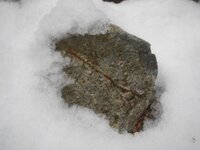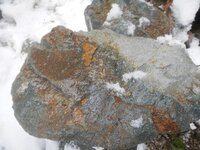Ragnor
Sr. Member
- Dec 7, 2015
- 445
- 422
- Primary Interest:
- All Treasure Hunting
I've been trying to sort this out in my head for a while. I didn't want to hijack anyone else's bench thread so here it goes.
My target area is about 4.5 miles down stream from the primary ore body which emplaced the free gold. The average mean grade from 'known' source to bench area is 12%.
The free milling gold veins are located between 3100 and 4100 feet ams.
The benches are between 1600 and 1800 feet ams.
conveniently located on the inside bend
[Image missing]
I half heartedly dug into the middle bench one day while taking a smoke break on my way into the canyon. Below the pumice layer I hit jaged pieces of bedrock and decided I was wrong, that I was not on a bench, just a flat spot. (long time ago)
Now that I can look at these modern images I am pretty darn certain it is a bench and that land slide materials have probably just covered the old river material.
My question is this, to the more experienced bench hunters.
given the information here would you guys concur with my supposition that these are old high bench stream channels and are the parameters listed condusive to a probable deposit worthy of further investigation?
Obviously the only real answer can be found on the ground in the field. None the less I would imagine the more seasoned fellers on here can get a pretty fair idea by the information provided.
My target area is about 4.5 miles down stream from the primary ore body which emplaced the free gold. The average mean grade from 'known' source to bench area is 12%.
The free milling gold veins are located between 3100 and 4100 feet ams.
The benches are between 1600 and 1800 feet ams.
conveniently located on the inside bend
[Image missing]
I half heartedly dug into the middle bench one day while taking a smoke break on my way into the canyon. Below the pumice layer I hit jaged pieces of bedrock and decided I was wrong, that I was not on a bench, just a flat spot. (long time ago)
Now that I can look at these modern images I am pretty darn certain it is a bench and that land slide materials have probably just covered the old river material.
My question is this, to the more experienced bench hunters.
given the information here would you guys concur with my supposition that these are old high bench stream channels and are the parameters listed condusive to a probable deposit worthy of further investigation?
Obviously the only real answer can be found on the ground in the field. None the less I would imagine the more seasoned fellers on here can get a pretty fair idea by the information provided.
Amazon Forum Fav 👍
Last edited:
Upvote
0






 Lot's and lots of research........ The most important part, so Ive found, is to know what your looking at when you see it.
Lot's and lots of research........ The most important part, so Ive found, is to know what your looking at when you see it.


